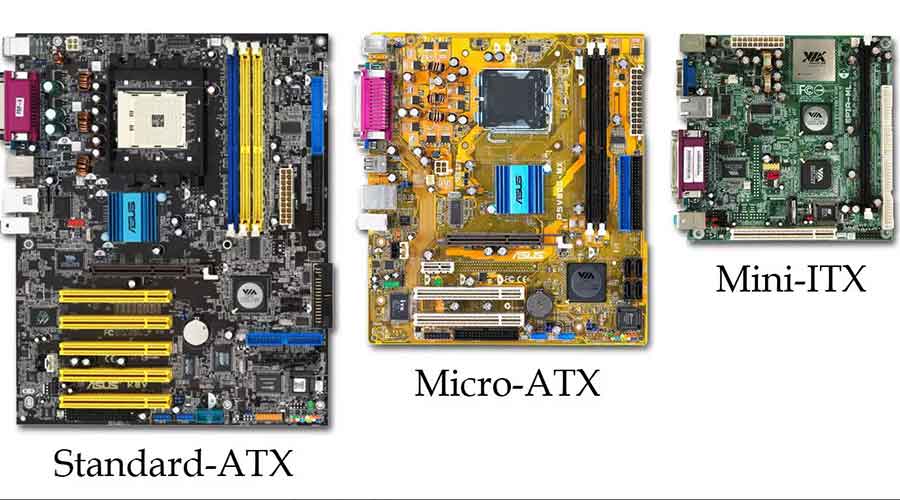As a beginner building a new PC, you've probably pondered the question - "can any motherboard fit into any case?"
To answer this simply: No.
Not every motherboard will fit into any PC case.
Motherboards come in many different shapes and sizes, depending on your needs.
This is also true for your PC case, so having a decently sized motherboard with a small form factor PC case won't work.
And if you get a large case with a small motherboard, you're not taking full advantage of the features bigger motherboards would have.
So to answer this question is in its entirety, there's some information you should know, which is laid out below.
Every motherboard has different specifications that detail the size, shape, and number of connectors it needs to fit into your case.
So no matter what type of motherboard you have, if it doesn't match up with your case's requirements, there will be some problems down the road!
So enough talk, let's get into the nitty-gritty!
There can be some limitations depending on the size, type of your motherboard forms factors, or how old the case is.
Motherboards are typically measured in ATX (Advanced Technology eXtended) form factor, referring to their length and width dimensions.
The most common types of motherboards are ATX and micro-ATX.
The motherboard can easily be put into a case designed to hold the size you need, but not every case will fit an ATP or Micro-ATX type of motherboard without some modifications.
If your current PC's motherboard is compatible with another computer's case, it can easily transfer your equipment.
The best way to know if the motherboard can fit in a particular case is by checking its specifications or looking at pictures and measurements for both items on an online retailer's website before purchasing it.

An ATX is a motherboard form factor that can be found in most desktop computers.
It can be described as the size of the board and can be used for all desktop computers that support the ATX board.
The micro-ATX can be used for desktop computers with a smaller form factor.
It can be described as having the size of the board that can be used for all desktop computers that can support micro-ATX boards.
The mini ITX (Information Technology eXtended) can be used for desktop computers with a smaller form factor.
It can be described as having the size of the board that can be used for all desktop computers that can support the Mini ITX boards.
What can you do to make sure your motherboard has the right specifications for your case?
With a couple of measurements and some research, it's not hard at all.
When it comes to getting the right case, you first need to find out what kind of PC you are looking to build.
Do you need a gaming setup to play graphics-heavy video games on high FPS?
Do you need a working setup that can handle resource-heavy software without lag?
Are you on a budget and want to just get the best value out of your PC components?
All of these factors will determine your budget, which in turn will determine what sort of parts you will get.
The best way to find the right PC case for your motherboard is to first find out what CPU you will be combining your motherboard with.
There are many great combinations out there, and depending on your needs will be the difference between getting a larger motherboard versus a smaller motherboard.
You can then measure the size of the motherboard according to its height, width, and length in centimeters or millimeters.
This should be specified on one of the manufacturer's pages.
Now you can find an aesthetically pleasing PC case so you can start building your setup.
If you're looking to go down the minimalist route for your setup, then you can check out our 7 best minimalist PC cases here.
Usually, on the manufacturer's page of the PC case, it will show you what kind of motherboard fits inside.
Whether it's a standard ATX motherboard or a mini-ATX motherboard, you should be able to quickly determine if it will fit into your PC case or not.
If you want to be extra safe, you can measure the interior of your case of where your motherboard is going to be.
You can probably find these specifications on one of its pages as well.
It may also be good to know which motherboard socket type you want to use so that you can make sure it will fit into your desired case (the most common are ATX and Micro-ATX).
After this, you should be able to start building your PC.
Pro Tip: Install as many PC components onto your motherboard as possible before you nail it into your PC case. That way you have a lot of room to play with, and won't need to struggle installing harder to reach components later.
Build a PC is a whole other ball game, so here's a video by Linus Tech Tips so you can get the general gist:
Computer cases are built with the description of a motherboard you want to fit into them.
That means they're not going to be universally compatible, and you'll need plenty of research if your case is old or new.
The best way to know whether or not your desired motherboard will fit into the case is to check its size specifications against the measurements of the case.
The easiest way to do this is by using a search engine or visiting an electronics store near you.
By now you should have a clear answer about whether or not any motherboard can fit into any case.
If you are uncertain of anything, continue to do your research, we have some awesome, informative articles for you to get started.
Happy building!